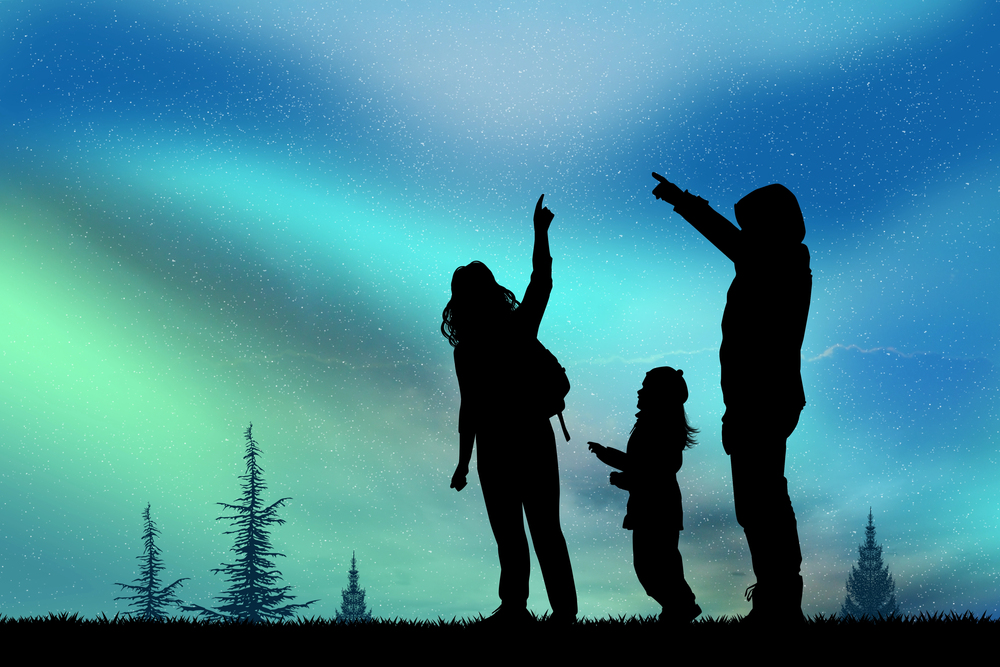Seeing the Northern Lights is a magical experience, especially for families with children. The aurora borealis, with its dancing lights and vibrant colors, creates unforgettable memories that your children will treasure for a lifetime. However, planning an aurora trip with kids requires some preparation to ensure everyone stays warm, comfortable, and happy during the adventure.
Here are the 6 best tips to make watching the Northern Lights with your kids a joyful and stress-free experience.

1. Choose the Best Time and Location
The first step in planning a successful Northern Lights outing with kids is choosing the right time and place. The Northern Lights are most visible in winter, during the darkest months between September and April. For families, this period can be a bit challenging due to the cold weather and shorter daylight hours, but it also offers the best chance to see the lights.
Best Time to See the Northern Lights
To make the most of your trip, plan to visit during the peak viewing times when the aurora is most active. The best time to see the Northern Lights in Rovaniemi is generally between late September and early April, especially during clear, cold nights. Visiting Rovaniemi, which lies within the Arctic Circle, is an excellent choice for families who want the opportunity to see the lights while also exploring the region’s kid-friendly attractions.
Choose Family-Friendly Locations
It’s also important to pick a location that is accessible and comfortable for kids. Areas around Rovaniemi are ideal because they provide a range of accommodations and services tailored to families. Many hotels offer activities that keep children entertained during the day while also being conveniently located near Northern Lights viewing spots. The beauty of staying in a place like Rovaniemi is that it combines adventure and comfort, giving kids and parents a balanced experience.
2. Dress Warmly and Comfortably
The aurora borealis usually makes its appearance on cold, clear nights, which means temperatures can be quite low, especially during the winter months. Dressing warmly is essential to ensure everyone stays comfortable, especially kids who can be more sensitive to cold temperatures.
Layering for Warmth
The key to staying warm is layering. Make sure your kids are dressed in moisture-wicking base layers, warm insulating mid-layers, and a windproof, waterproof outer layer. The extremities—hands, feet, and head—are particularly vulnerable to the cold, so bring warm gloves, thick socks, insulated boots, and hats. It’s a good idea to also carry extra gloves and socks, as they can get wet when playing in the snow.
Blankets and Hot Drinks
Another great way to keep kids comfortable while waiting for the Northern Lights is to bring blankets and hot drinks. A thermos filled with hot chocolate can make the experience cozier, while a warm blanket helps keep everyone comfortable if they get tired of standing or sitting in the cold. Some tour companies even provide reindeer hides to sit on, adding a little extra warmth and authenticity to the experience.
3. Be Patient and Plan Entertainment
The Northern Lights are a natural phenomenon and don’t always follow a predictable schedule, which means you may need to wait for hours, or sometimes even on multiple nights, before you can see them. Patience is crucial, especially when traveling with children who may find the waiting time challenging.
Bring Games or Activities
To make waiting more enjoyable, bring some entertainment. Small games, activity books, or even an aurora-themed story to read out loud can keep the kids engaged while waiting for the lights to appear. If they are old enough, consider using the time to teach them about the science behind the aurora borealis. This will make the experience even more meaningful for them.
If you’re looking for simple and fun facts to help explain the aurora to your children, check out this guide to Northern Lights facts for kids. It’s a great way to make learning about the aurora both educational and entertaining.

Set Realistic Expectations
It’s also important to set realistic expectations. The Northern Lights are unpredictable, and there is no guarantee they will show up, even if the conditions are right. Letting your kids know this in advance can help avoid disappointment and make the experience more about the adventure itself rather than just the end result.
4. Sleep Under the Northern Lights
One of the best ways to enjoy the Northern Lights as a family is to sleep under them. Many accommodations in the Arctic Circle offer specially designed igloos or cabins with glass roofs that provide a comfortable place to watch the aurora. This way, you and your kids can stay warm while looking up at the magical lights—no need to wait outside in the cold.
Glass Igloos and Northern Lights Cabins
Staying in a glass igloo or cabin, such as those available in Rovaniemi, is a perfect choice for families. It allows you to keep an eye out for the lights while the kids are already snug in bed, making the experience much easier for young children who might otherwise struggle with staying up late.
The experience of sleeping under the Northern Lights can be magical for kids, making them feel like they are in a fairytale. It’s a family experience that blends comfort, adventure, and a little bit of luxury.
5. Check the Aurora Forecast and Weather Conditions
When planning a trip to see the Northern Lights, it’s crucial to check the aurora forecast and the weather conditions to maximize your chances of seeing them. The aurora is more likely to be visible on clear nights with minimal cloud cover.
Aurora Forecast Tools
Several online tools can help you predict when the Northern Lights will be active. The aurora forecast for Rovaniemi is an excellent resource for families planning a viewing. It provides updates on auroral activity, allowing you to plan your outing when the chances of seeing the lights are highest.
It’s also wise to check local weather forecasts, as cloud cover can prevent you from seeing the aurora even if they are active. Keep in mind that the best time to see the Northern Lights is usually between 9 PM and 2 AM, so you may need to adjust your child’s sleep schedule if you plan on staying out late.
6. Capture the Moment
Watching the Northern Lights is a magical moment, especially for children, and capturing it on camera can help preserve these memories for years to come. However, photographing the aurora can be challenging, particularly if you’re new to night photography.
Tips for Aurora Photography with Kids
If you’re planning to take photos, it’s a good idea to practice your photography skills beforehand. You’ll need a good camera, preferably one that allows you to manually adjust the shutter speed, aperture, and ISO. To make the process easier, bring a tripod to keep the camera steady during the long exposure needed to capture the aurora.
For families, the key is to keep it simple. Take a few moments to snap some photos but try not to get too wrapped up in taking the perfect picture—remember to put the camera down and just enjoy the moment with your kids. For more detailed tips, check out this guide on photography for capturing the Northern Lights.
Another great way to make the experience memorable is to encourage your kids to bring their own small camera or even use a smartphone to capture the lights from their perspective. They will love having their own photos to look back on and share with friends.
Whether you’re cozy in a glass igloo or standing outside under the stars, seeing the Northern Lights with your children will be a moment that none of you will ever forget. With these tips in mind, your family’s Northern Lights adventure is sure to be a once-in-a-lifetime experience filled with awe, excitement, and joy.
